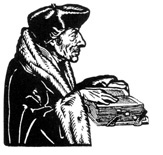St. Thomas More: No Common Grounder

The King's Good Servant But God's First: The Life and Writings of St. Thomas More
By James Monti
Publisher: Ignatius
Pages: 457
Price: $19.95
Review Author: George Neumayr
James Monti does not subscribe to the Robert Bolt school of Thomas More appreciation. For Monti, More was not a humanist martyr for conscience’s sake (as Bolt portrayed him in A Man for All Seasons) but an orthodox stalwart willing to die in a “battle to preserve England’s thousand year communion with the see of Peter.”
More was an unusually pious young man, says Monti, and in his mid-twenties he “gave serious consideration to the idea of entering the priesthood and the religious life,” spending at least “part of each day participating in the spiritual exercises of the Carthusian monks of London’s Charterhouse.”
More maintained this rigorously spiritual life even after he married, adopting practices many modern vowed religious would no doubt find appallingly severe, such as wearing a hairshirt, or rising at two o’clock in the morning to devote the first five hours of his day to prayer and study.
More attended Mass daily, often serving the priest at the altar. He read spiritual works voraciously, including Thomas à Kempis’s Imitation of Christ, St. Bonaventure’s Meditationes Vitae Christi, and Walter Hilton’s Scale of Perfection. More’s passion for prayer and study led him to build an oratory on the grounds of his estate in Chelsea, to which, says Monti, he would withdraw “upon returning from Henry VIII’s court functions in order to recollect himself.”
More’s religious intensity permeated his household. Upon rising, his children would recite the seven Penitential Psalms and the Litany of the Saints. At meals, the children would read aloud from Scripture and then from a pertinent commentary or spiritual book. In the evening, More “would gather the entire household to recite more psalms and the Marian hymn Salve Regina.”
More expected his entire household (which, we are told, included a jester) to attend Mass on Sundays and feast days. He brooked no worldly nonsense at Mass, according to Monti: “The saint’s sense of profound reverence for holy places was such that when he was in church he would invariably refuse to talk or hear of any temporal matters.” Not even a summons from the king could move him. “More replied that he would come, but only after he had finished paying homage ‘to a higher king.'”
More’s profession of lawyer had little sway over his soul. He saw that profession as a boring distraction from his study of philosophy and theology. What really interested More was apologetics. He had no tolerance for dissent, and thought that educated men had a duty to “set their pens to the book” in order to stop the spread of error and heresy in the Church: “For every good man is bounden between truth and falsehood, the Catholic Church and heretics, between God and the devil, to be partial, and plainly to declare himself to be full and whole upon the one side and clear against the other.”
Monti says that More compared dissenting clergy to Judas. Like that traitor with his kiss in the garden, wrote More, such priests “consecrate the most holy body of Christ and then put to death Christ’s members, Christian souls, by their false teaching and wicked example.” Dissenters, More said bluntly, would have the people “reject and refuse the faith” that “holy martyrs lived and died for.” The heresies attacking the Church’s Eucharistic theology made More particularly indignant. The Mass is first and foremost a sacrifice, he wrote, not a meal. The Protestant heretics, like William Tyndale, sought to “drive God out of Christendom, when they would expel Christ out of the Sacrament of the Altar.”
Monti informs us that More even had to address the issue of women priests — another of Tyndale’s enthusiasms. More responded to Tyndale with a touch of sarcasm (“O the tender heart of piteous Tyndale”) and with the perennial point that Christ didn’t appoint women, not even His Blessed Mother, to the priestly office. Monti writes that over “the last twenty years it seems that More has been put on trial again, charged with the supposed ‘treason’ of being too ardent a defender of Catholic orthodoxy.” A pathetic accusation, to be sure.
Shortly before More’s death, King Henry VIII conducted what can only be called a smear campaign against More and Bishop John Fisher, employing turncoat English bishops to do the dirty work and accusing More and Fisher of the unpardonable sin of being divisive. Sound familiar? It seems the more things change, the more they stay the same. To the heretics of More’s day — forerunners of the Americanists and compromisers of our day — More was a cranky papal maximalist. But to the mind of the Church he was a saint and, as Monti successfully shows, a “model layman living the Gospel to the full.”
You May Also Enjoy
Reviews of Can Somebody Shout Amen!... Confessions of a Twentieth-Century Pilgrim... Socialism in the Heartland: The Midwestern Experience, 1900-1925
Robert N. Bellah, in his widely acclaimed Habits of the Heart, has said that Americans…
Tate was a critic, poet, novelist, and intellectual of the first rank. Neglect of his work today is due in large part to his conversion to Catholicism.

